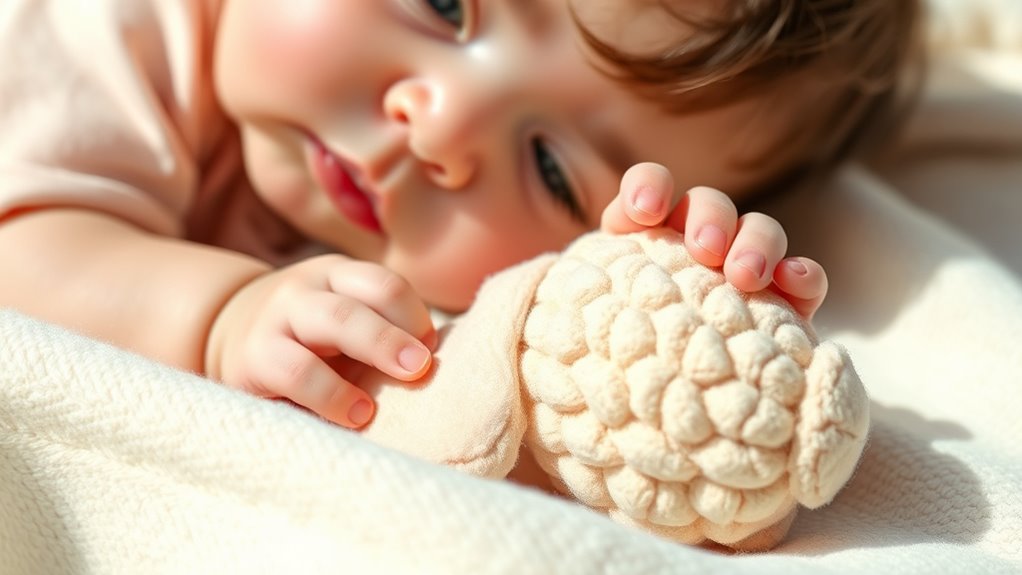Sensory play for babies under six months helps their brain grow, develop motor skills, and explore the world with curiosity. You can start with simple activities like gentle touches, visual stimulation with high-contrast images, calming sounds, or using everyday items like soft fabrics or rattles. Creating a calm, clutter-free space makes exploration safe and enjoyable. If you keep exploring, you’ll discover more ways to support your baby’s sensory development effectively.
Key Takeaways
- Engage babies with gentle tactile activities using soft fabrics and skin contact to promote sensory development.
- Use high-contrast images and bright colors to stimulate visual curiosity and focus.
- Introduce soothing sounds like humming, white noise, or nature sounds to support auditory growth.
- Incorporate familiar, safe objects such as wooden spoons or lightly scented cloths for varied sensory input.
- Create a calm environment with soft lighting and simple textures to encourage exploration and comfort.
Understanding the Benefits of Sensory Play for Young Babies
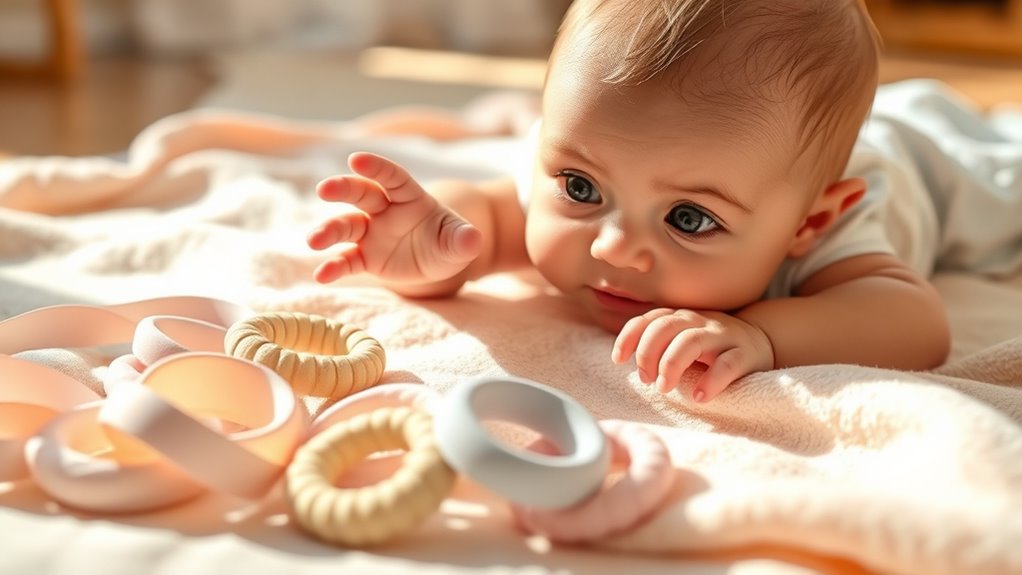
Sensory play is essential for babies under six months because it supports their overall development and helps them explore the world around them. When you engage your baby in sensory activities, you promote their brain growth, improve motor skills, and enhance their ability to process new information. These experiences help strengthen neural connections, laying a foundation for future learning. Color accuracy in sensory toys and environments can also stimulate visual development and engagement. Sensory play also encourages curiosity and confidence, making your baby more comfortable trying new things. Additionally, it provides comfort and security, especially when activities involve gentle touches or soothing textures. By offering age-appropriate sensory experiences, you’re nurturing your baby’s natural instincts to explore, learn, and develop essential skills that will benefit them throughout their early years and beyond.
Safe and Simple Sensory Activities for Newborns and Infants
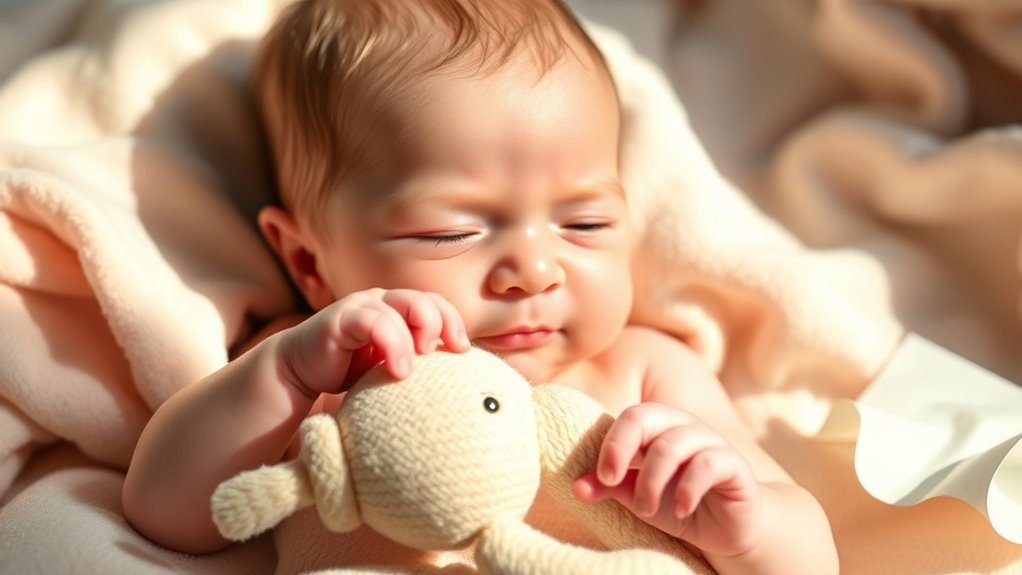
Introducing safe and simple sensory activities for your newborn or infant helps you foster development while guaranteeing their well-being. Start with gentle touch, such as softly stroking their hands, feet, or face, to promote tactile awareness. Use clean, soft fabrics or your own skin to provide comforting textures. Brightly colored or high-contrast images placed within their view can stimulate visual development. Soft, calming sounds, like gentle humming or white noise, can soothe and engage their hearing. Keep activities short—just a few minutes at a time—and always observe your baby’s reactions. Ensure that any objects or materials are clean, safe, and free of small parts that could pose a choking hazard. Incorporating sensory-rich environments can further support their development and curiosity. These simple activities support their senses and build a foundation for future exploration.
Using Everyday Items to Stimulate Your Baby’s Senses
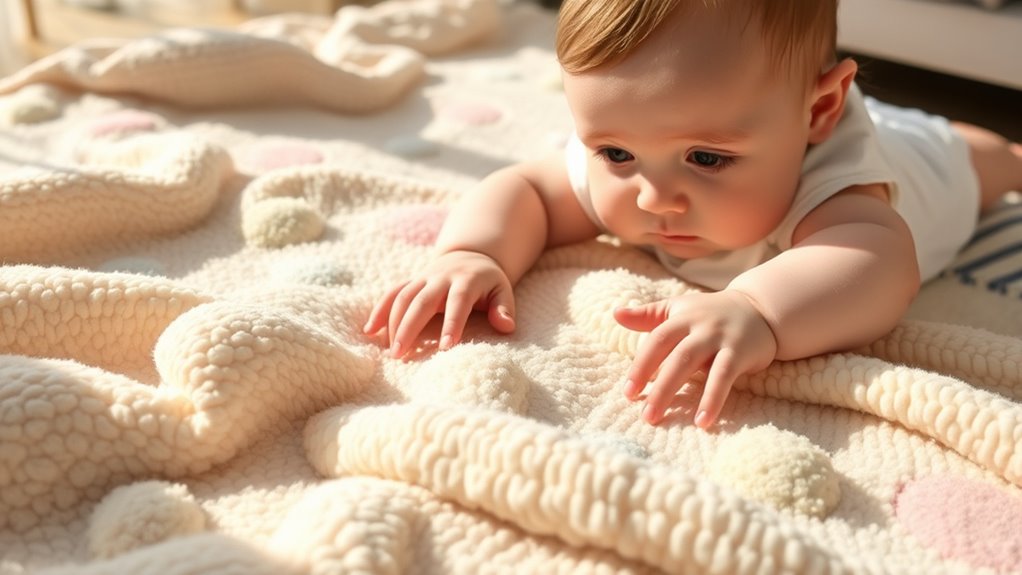
You can easily stimulate your baby’s senses by using everyday items around the house. Soft fabrics like a clean sock or a piece of fleece provide gentle texture for touch. Brightly colored or patterned cloths catch your baby’s attention and encourage visual exploration. A wooden spoon or a plastic lid can serve as safe, lightweight objects to rattle, creating sound and engaging your baby’s hearing. Introducing safe, scented items like a vanilla-scented wipe or a lightly scented cloth can activate their sense of smell. Just ensure all items are clean, free of small parts, and appropriate for your baby’s age. Using familiar objects helps your little one connect with their environment and encourages curiosity through simple, safe, everyday items. For added variety, incorporating sensory play with different textures and sounds can further enhance their development.
Creating a Calm and Engaging Sensory Environment at Home
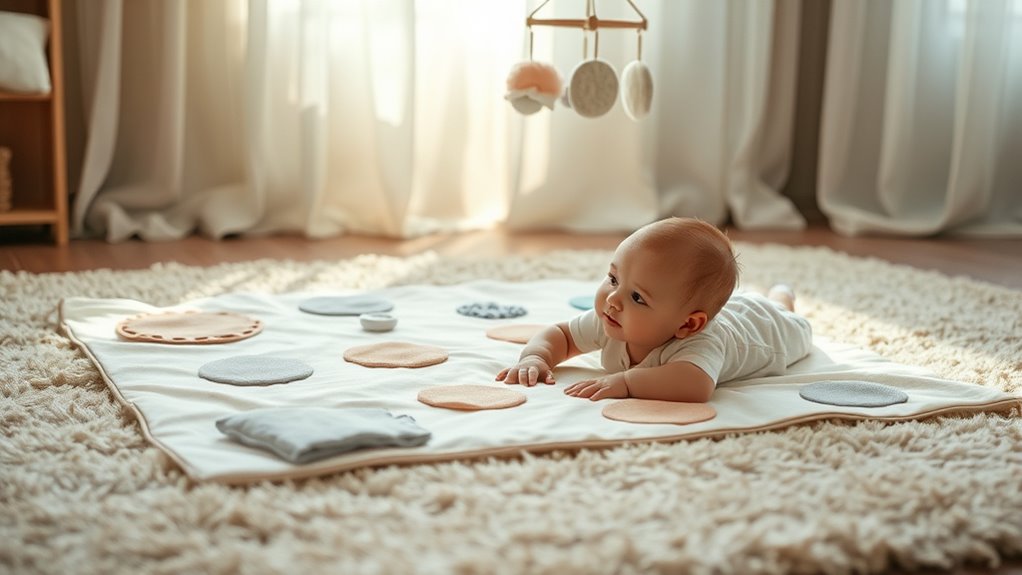
Creating a calm and engaging sensory environment at home starts with organizing a peaceful space free from overstimulation. Choose a quiet corner with soft lighting and minimal noise to help your baby focus on sensory experiences. Use gentle textures, calming colors, and simple toys to create a soothing atmosphere. Keep the area tidy and free of clutter, so your baby feels safe and comfortable. Incorporate soft fabrics, natural elements, and age-appropriate objects to stimulate senses without overwhelming. Use this table to plan your space:
| Sensory Element | Example |
|---|---|
| Textures | Soft blankets, plush toys |
| Visuals | Gentle colors, simple patterns |
| Sounds | Quiet music, nature sounds |
| Scents | Mild, natural aromas like lavender |
Additionally, integrating mindfulness techniques such as deep breathing or gentle visualizations can help create a more peaceful environment for your baby and caregiver alike.
Tips for Observing and Supporting Your Baby’s Sensory Exploration

Pay close attention to your baby’s reactions during sensory activities, as these cues reveal their preferences and developmental progress. Watch for signs like eye contact, reaching, or turning away, which indicate their interest level. To support their exploration effectively:
- Follow their lead—offer new textures, sounds, or visuals based on their responses.
- Create a safe space—remove hazards and ensure comfort so they feel secure trying new sensations.
- Engage actively—talk, smile, and mimic their reactions to encourage curiosity and connection.
- Recognizing and responding to these cues can also foster trust and emotional security during their sensory exploration emotional development.
Frequently Asked Questions
How Can I Tell if My Baby Is Overstimulated During Sensory Play?
You can tell if your baby is overstimulated by watching for signs like turning their head away, fussing, or rubbing their eyes. If they seem overwhelmed or become fussy quickly, it’s a sign to pause the activity. Keep sensory play short and simple, and pay close attention to your baby’s cues. When they start showing signs of overstimulation, give them a break and offer calming comfort.
Are There Any Sensory Activities to Avoid With Certain Health Conditions?
You might wonder if any sensory activities could be harmful, and it’s smart to ask. Some health conditions, like eczema or respiratory issues, mean you should avoid highly scented or textured materials that could irritate your baby’s skin or lungs. Always consult with your pediatrician before introducing new activities, especially if your baby has health concerns. Staying cautious guarantees your tiny explorer stays safe and happy while discovering their world.
How Often Should I Introduce New Sensory Experiences to My Baby?
You should introduce new sensory experiences to your baby gradually, about once a week or as they show interest. Watch for signs of overstimulation or fussiness, and respond by pausing or switching activities. Pay attention to their cues and guarantee activities are safe and age-appropriate. Consistent, gentle exposure helps your baby explore their senses without overwhelming them, supporting healthy development and curiosity.
Can Sensory Play Help With My Baby’s Developmental Milestones?
Did you know that early sensory experiences can boost your baby’s brain development by up to 20%? Sensory play helps with milestones like grasping, focusing, and recognizing textures. By engaging your baby’s senses, you support their cognitive, motor, and emotional growth. You should introduce new experiences gradually, observing their reactions, and making playtime enjoyable. This way, you actively nurture your baby’s development in a fun, interactive way.
What Signs Indicate My Baby Is Ready for More Complex Sensory Activities?
You notice your baby shows curiosity by tracking objects with their eyes, reaching out, or exploring with their hands. When they start to enjoy more varied stimuli and respond actively, it’s a sign they’re ready for more complex sensory activities. If they can sit with support or show increased focus during play, these are good indicators. Always watch for signs of overstimulation and adjust activities accordingly to keep your baby engaged and comfortable.
Conclusion
By exploring gentle textures, soft sounds, and calming visuals, you create a world of wonder right at home for your little one. Imagine their tiny fingers reaching out to discover a cozy blanket’s plushness or their eyes lighting up at a shimmering mobile. As you guide their sensory journey, you nurture curiosity and comfort. Together, you build a nurturing space where your baby’s senses blossom, laying the foundation for joyful exploration ahead.
